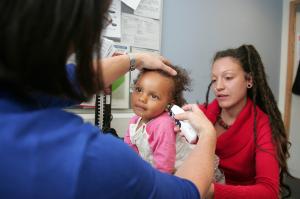2015
Who is closer - your doctor or your pharmacist?

If you have easy access to good healthcare, your chances of being healthy are significantly increased. That’s not rocket science.
However, who can provide what, who can give easy access to health advice, and more importantly, what is the best way to reduce health inequalities is not always as clear cut.
New research, led by Fuse Associate Dr Adam Todd and colleagues from Durham University including Fuse Associate Director Professor Clare Bambra, has looked at this issue.
Below the research team answer a few questions about the study.
What did you find in your research?
Our study shows that more people live within a 20 minute walk of a community or high street pharmacy than they do to a GP practice. Access is good for both healthcare services but statistically there is better access to pharmacies compared to GPs.
The percentage of the population living within easy walking distance from a pharmacy is 89 per cent compared to 85 per cent for GPs. In deprived areas, the figures are even higher with 100 per cent easy access to pharmacies and 98 per cent to GP practices.
The findings show that the often-quoted inverse care law, where good medical care is most available to those who need it least, does not apply.
Why is this research important?
There are major public health issues which are putting huge pressures on the health service, and GPs in particular, such as obesity, smoking and alcohol dependence. More people die from these conditions in deprived areas compared to affluent communities and the gap in life expectancy between these areas has widened.
With easy access to high street pharmacies, without a need to make an appointment, community pharmacies are well-placed to help tackle some of these major public health concerns, working alongside GPs.
This is particularly important in poor areas to help improve health and narrow the gap in health inequalities.
How did you carry out your research?
We used postcodes for all community pharmacies and GP practices in England and coordinates of each postcode for the population. These were then matched to a deprivation index as well as to the type of area, e.g. urban, town and fringe, hamlet or isolate dwelling.
Who did you work with on this research?
The research team from Durham University was made up of experts in public health, pharmacy, health inequalities and statistics. It consisted of Dr Adam Todd and Dr Andy Husband (School of Medicine, Pharmacy and Health), Dr Alison Copeland and Dr Kasim Adetayo (Wolfson Research Institute for Health and Wellbeing) and Professor Clare Bambra (Department of Geography).
What are the next steps?
GP practices and community pharmacies are both commissioned to provide public health services, such as flu vaccines and smoking cessation. Although we now know from our study what access looks like to family doctors and pharmacists, we do not know yet who uses which services and how patients feel about going to their pharmacist or GP for advice on conditions such as smoking.
Crucially, further work is needed to establish the best way to reduce health inequalities.
Should we empower community pharmacies to provide more public health services, for GP practices to do this, or a mix of both?
Last modified: Tue, 31 Jul 2018 09:13:41 BST





